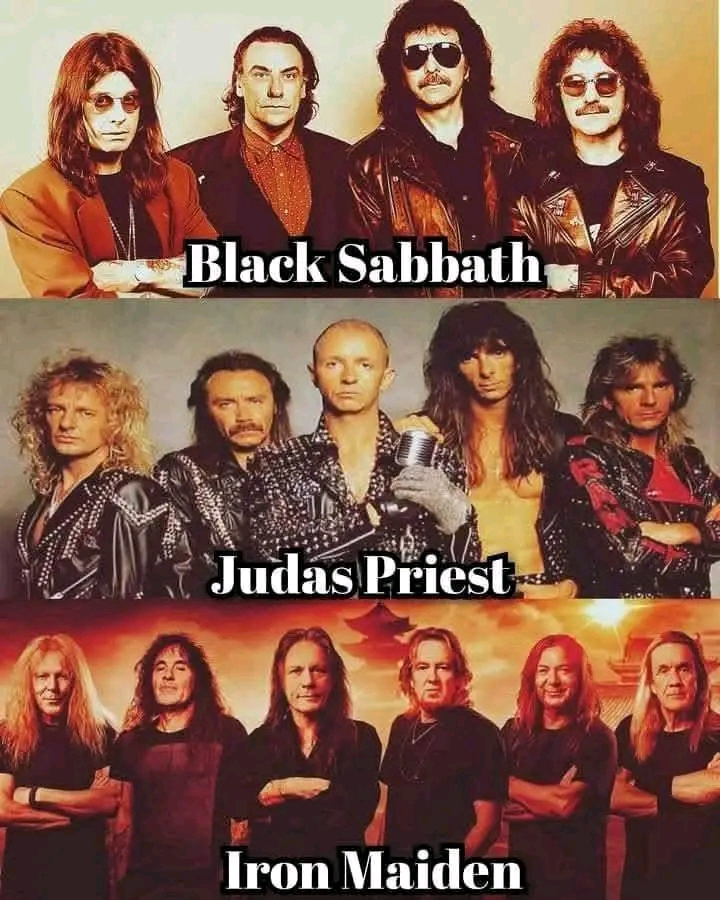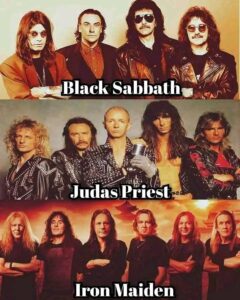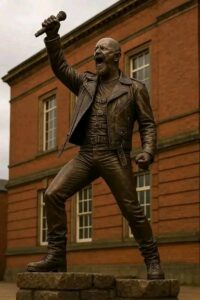
In the dim glow of a smoky club in Birmingham, England, the air vibrated with anticipation. It was the early 1970s, a time when rock was evolving, but no one quite knew what was coming next. Out of this fertile ground emerged three bands—Judas Priest, Black Sabbath, and Iron Maiden—each destined to become the titans of heavy metal. But their stories weren’t just about music; they were about rebellion, innovation, and forging a genre that would shake the world.
The Birth of Darkness: Black Sabbath
It all began with Black Sabbath. Led by the enigmatic Ozzy Osbourne, guitarist Tony Iommi, bassist Geezer Butler, and drummer Bill Ward, the band started playing in local clubs. Their sound was unlike anything heard before—a heavy, doom-laden mixture of blues and horror-inspired lyrics. The dark riffs of “Black Sabbath” and “War Pigs” captivated audiences, creating an ominous atmosphere that felt like the soundtrack to a nightmare.
Ozzy (voice trembling): “We just wanted to make music that scared people. That’s what felt right—something raw, real, and dark.”
Their debut album in 1970 became an instant classic, defining the genre as “doom metal” and setting a foundation that others would build upon. Sabbath’s influence was undeniable—they showed that metal could be heavy, dark, and theatrical.
The Rebellion Begins: Judas Priest
While Sabbath pioneered the dark sound, Judas Priest brought a new intensity and attitude. Formed in 1969 by Rob Halford, Glenn Tipton, and K.K. Downing, Judas Priest’s early years were marked by experimentation. But by the mid-70s, they found their identity: leather, studs, and anthems of rebellion.
Rob Halford (with a grin): “We wanted to look and sound like the kings of the street. Heavy metal was about power—our music, our attitude. We weren’t just playing; we were declaring war.”
Their 1978 album Stained Class and the subsequent British Steel in 1980 featured iconic tracks like “Breaking the Law” and “Living After Midnight,” cementing their reputation as the genre’s leather-clad rebels. Halford’s soaring vocals and Tipton’s and Downing’s twin guitars created a wall of sound that was both aggressive and melodic. The Epic Stage: Iron Maiden
Meanwhile, in London, a band called Iron Maiden was emerging, driven by the visionary bassist and songwriter Steve Harris. Their debut album, Iron Maiden (1980), introduced the world to a new level of spectacle—widescreen storytelling with epic themes drawn from history, mythology, and literature.
Bruce Dickinson (vocalist): “We wanted to do more than just music—we wanted to tell stories. Our stage shows were like theatrical productions, with costumes and imagery that transported our fans to another world.”
Their mascot, Eddie, became a symbol of the genre, and albums like The Number of the Beast and Powerslave pushed the boundaries of heavy metal’s complexity and grandeur. Iron Maiden’s relentless touring and elaborate stage shows set new standards for live performances.The Clash of Titans
As the 1980s dawned, these three bands became the kings of heavy metal, each with its own unique identity. Sabbath’s dark, doom-laden riffs influenced countless bands, from Metallica to Slayer. Judas Priest’s leather and attitude became iconic, inspiring generations of metalheads. Iron Maiden’s storytelling and theatricality elevated metal into an art form.
Yet, the scene was also marked by rivalry and innovation. Metallica, Slayer, and others took the genre into thrash and extreme territories, but Sabbath, Priest, and Maiden remained the core—pioneers who built the blueprint.

Decades later, their influence is everywhere—from the riffs of Metallica’s “Master of Puppets” to the stage theatrics of modern bands. The genre they created isn’t just music; it’s a lifestyle, a statement of rebellion and power.
Fan (at a concert): “They’re the kings. No one’s touched what Sabbath, Priest, and Maiden started. They created the sound of rebellion—heavy, loud, and unapologetic.”
Their stories are woven into the fabric of rock history. Each band—Black Sabbath’s dark echoes, Judas Priest’s leather rebellion, Iron Maiden’s epic storytelling—contributed a piece to the grand mosaic of heavy metal. And even today, their music roars on, a testament to their status as the true kings of heavy metal. Epilogue: The Legacy Continues
As a new generation of metal bands rises, paying homage and pushing boundaries further, the roots laid by these legendary bands remain solid. Their influence is felt not just in music, but in the attitude—a spirit of defiance that refuses to die.
In a world that often seeks to silence dissent, the true kings of heavy metal remind us: power, rebellion, and storytelling are eternal. Their legacy is not just in their records but in every heavy riff that shakes the earth and every voice that screams in defiance.
Fade out with the roaring guitar solo of “The Trooper,”as the stage lights dim, leaving an indelible mark on the soul of heavy metal.




